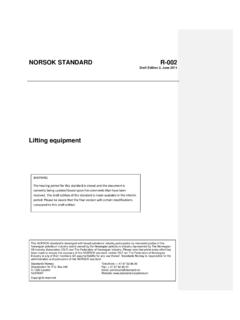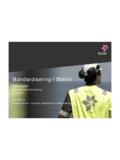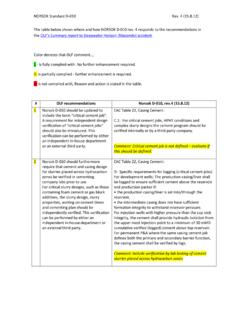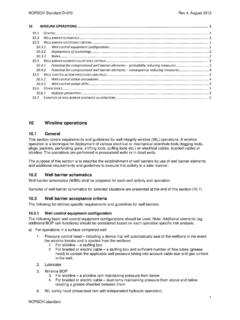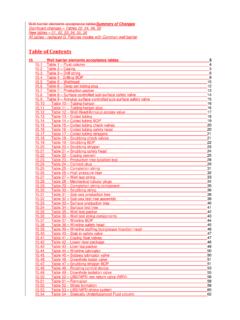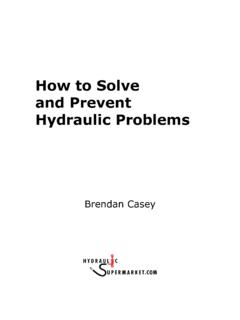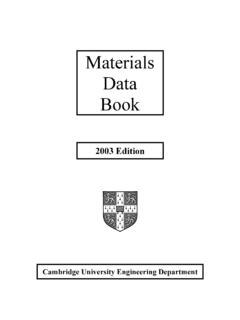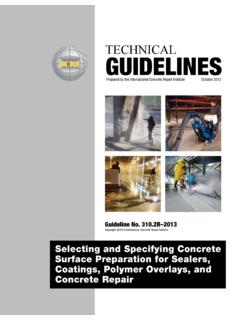Transcription of 011c 011j e V31 - standard.no
1 EN 13445-1:2002 (E) Issue 28 (2007-08) 11b The testing group of the vessel according to of EN 13445-5:2002. The available testing groups depend upon the material group, thickness, and welding method. Category 4 is further limited with regards to pressure, temperature, content, number of cycles, design stress, and dimensions. NOTE 3 The testing group affects not only the testing requirements but also design and manufacturing aspects, , joint coefficient, permitted weld details and required weld production tests. NOTE 4 Although the same testing group normally applies to the whole vessel, it is (with the exception of Group 4) permissible to have different testing groups apply to different parts ( , welds).
2 Materials General Specific requirements for steels are given in Part 2. NOTE Specific rules for spheroidal graphite cast iron and aluminium are given in Part 6 (see in this annex) and part 8 (see in this annex), respectively. In some instances, references may be made from these parts to Part 2. Permitted materials Only materials which are qualified for pressure equipment may be used. Qualification of materials can be made in three different ways Materials from European harmonized Standards, see of EN 13445-2:2002; Certain materials supplied in accordance with European material Standards are accepted as qualified for use in pressure-bearing parts.
3 These materials are enumerated in Table of EN 13445-2:2002. Materials with a European Approval for Materials (EAM), see of EN 13445-2:2002; Materials with an EAM, which states that they can be used for products under the PED, are qualified for use in relevant products according to this standard. EAMs are published in the Official Journal, and the European Commission maintains a list of EAMs on their web site NOTE 1 This web site is presently accessible under the address pressure_equipment/ Materials with a Particular Material Appraisal (PMA) , see of EN 13445-2:2002. Materials, which have been subject to a PMA are qualified.
4 This appraisal is carried out by the manufacturer (and in certain cases checked by a Notified Body). NOTE 2 The European Commission and Member States have in November 2006 agreed on Guiding Principles for the contents of Particular Materials Appraisals. The document is published on, Whichever method of qualification is used, the qualification does not necessarily cover the suitability of the material with regards to the environment and content of the vessel, , corrosion, erosion, etc. The manufacturer will always have to evaluate the material's resistance to such action. Whichever way the material has been qualified, all other rules in Part 2 will have to be fulfilled.
5 EN 13445-1:2002 (E) Issue 31 (2008-06) 11c Prevention of brittle fracture Rules for prevention against brittle fracture are given in Annex B of EN 13445-2:2002. Three different routes are allowed. Reliance on operating experience ( of EN 13445-2:2002) A combination of operating experience and fracture mechanics ( of EN 13445-2:2002) Fracture mechanics ( of EN 13445-2:2002) The first two methods aim at determining a relationship between the lowest material temperature in the vessel (TM) and the temperature at which impact testing (TKV) has to be performed, and they are both limited with regards to materials and thicknesses. NOTE A revised version of method 1 and method 2, based on latest European research results in engineering crititcal assessment methods is currently under preparation.
6 The third method allows the use of engineeing critical assessment methods when methods 1 and 2 are not suitable for material selection. This method requires more work than the first two. Material grouping Materials are grouped in Table of EN 13445-2:2002 with respect to major chemical elements, specified minimum tensile test data. This grouping is used throughout the standard to decide design, manufacturing, and inspection aspects. Design General Most of the requirements for design are to be found in Part 3. NOTE Specific design rules for vessels manufactured from spheroidal graphite cast iron and aluminium are given in Part 6 (see in this annex) and Part 8 (see in this annex), respectively.
7 Design for static loads There are four different methods for design, which can be used either separately or in combination with each other Design by formulas (DBF) These rules are contained in Clauses 7 to 16 and 21 of EN 13445-3:2002 and Annexes F, G, GA and J of EN 13445-3:2002. For simple geometries such as cylinders and spheres, formulas can be given where pressure and geometrical dimensions give the required minimum thicknesses directly. For more complicated geometries, a trial-and-error approach must be used in most cases. The designer will have to assume the analysis thickness(es), and use the formulas to compute the stresses and/or the load ratios as applicable.
8 These stresses and/or load ratios are then compared with allowable values. Figure 3-1 of EN 13445-3:2002 shows the relations between different thickness definitions. In the design formulas of components having a governing weld, the weakening effect of that weld is accounted for by means of a weld joint coefficient z. The maximum allowed value of this coefficient depends upon the testing group of the weld as specified in of EN 13445-5:2002. NOTE 1 Governing welds are listed in of EN 13445-3:2002. EN 13445-1:2002 (E) Issue 31 (2008-06) 11d For two types of components, flange connections and heat exchanger tubesheets, a multiple sets of rules are given (in Clause 11 of EN 13445-3:2002, Annex G of EN 13445-3:2002, and Annex GA of EN 13445-3:2002, in Clause 13 of EN 13445-3:2002 and Annex J of EN 13445-3:2002, respectively).
9 The alternative rules of Annexes G, GA and J of EN 13445-3:2002 are based on more advanced methods than their corresponding main clause, and are expected to lead to more appropriate and less conservative designs. Either set can be used at the designer's option within the limitations given for each set. NOTE 2 Annex G is recommended for the design of flange connections where the flanges are subject to strong leak-tightness requirements, significant thermal cycling, and/or significant additional loads (forces or moments). It implies that the bolt stress is controlled by the use of a defined tightening procedure. NOTE 3 Annex GA is a further development of Annex G.
10 It may be used particularly for flange connections in vessels containing gases or vapours, for which it is necessary to fix a maximum allowable leak rate. NOTE 4 Annex J is recommended for the design of heat exchanger tubesheets subject to relatively low cyclic loading. Design by analysis using direct assessment of failure modes (DBA - Direct Route) These rules are contained in Annex B of EN 13445-3:2002. For each failure mode a specific assessment method is provided ( : limit analysis for assessment of gross plastic deformation, shakedown analysis for progressive deformation). Design by analysis using stress categorization (DBA Method based on stress categories) These rules are contained in Annex C of EN 13445-3:2002.

